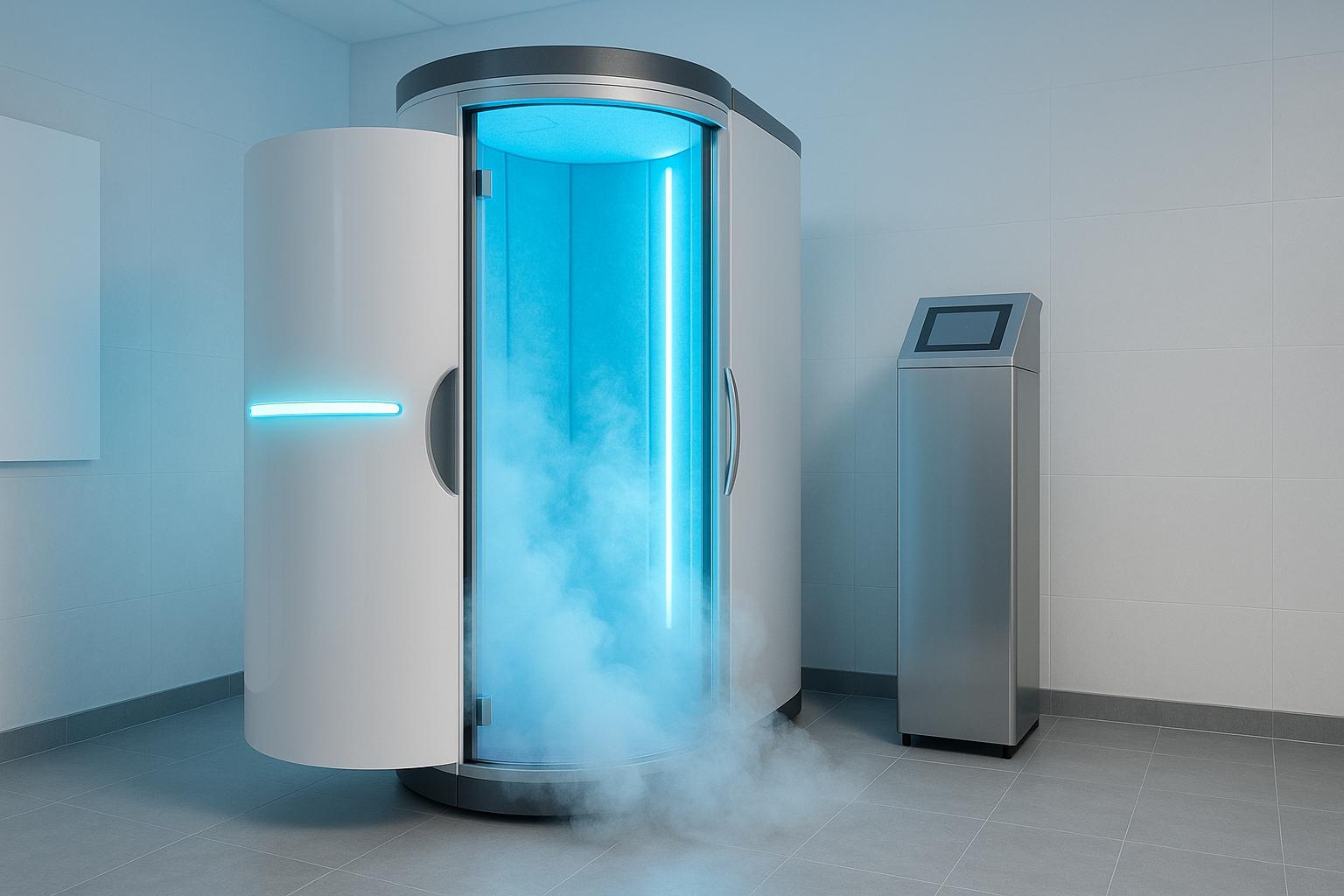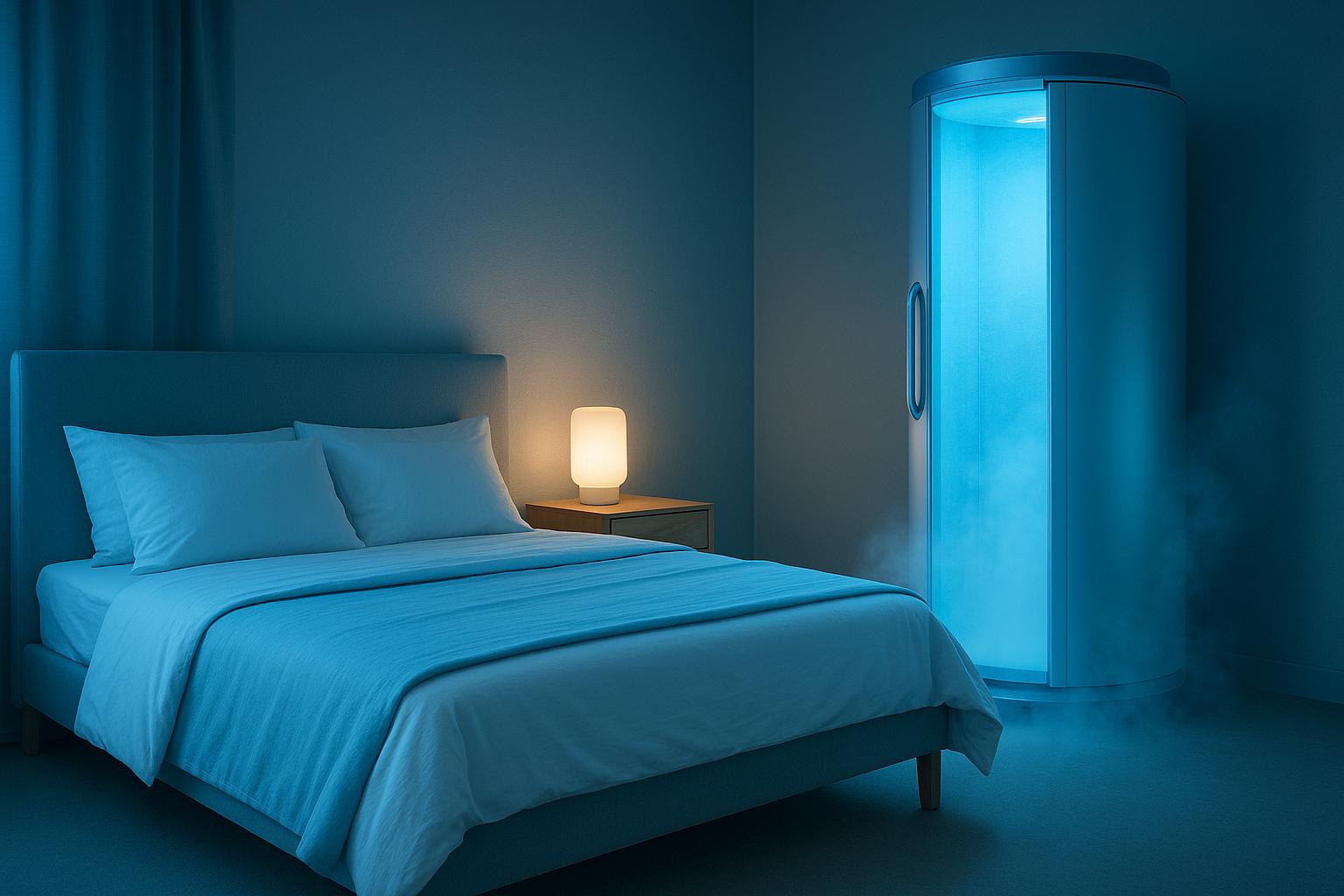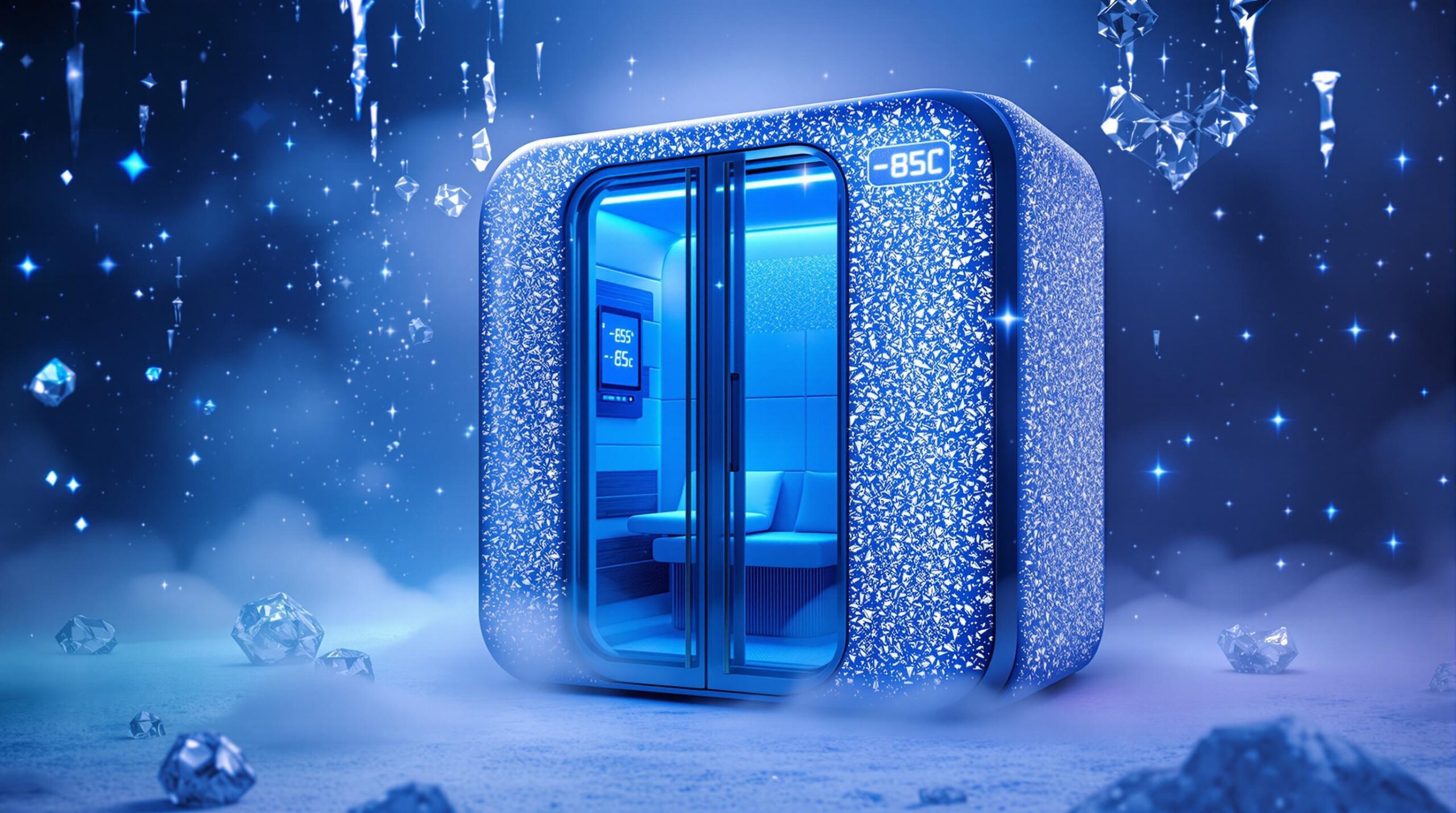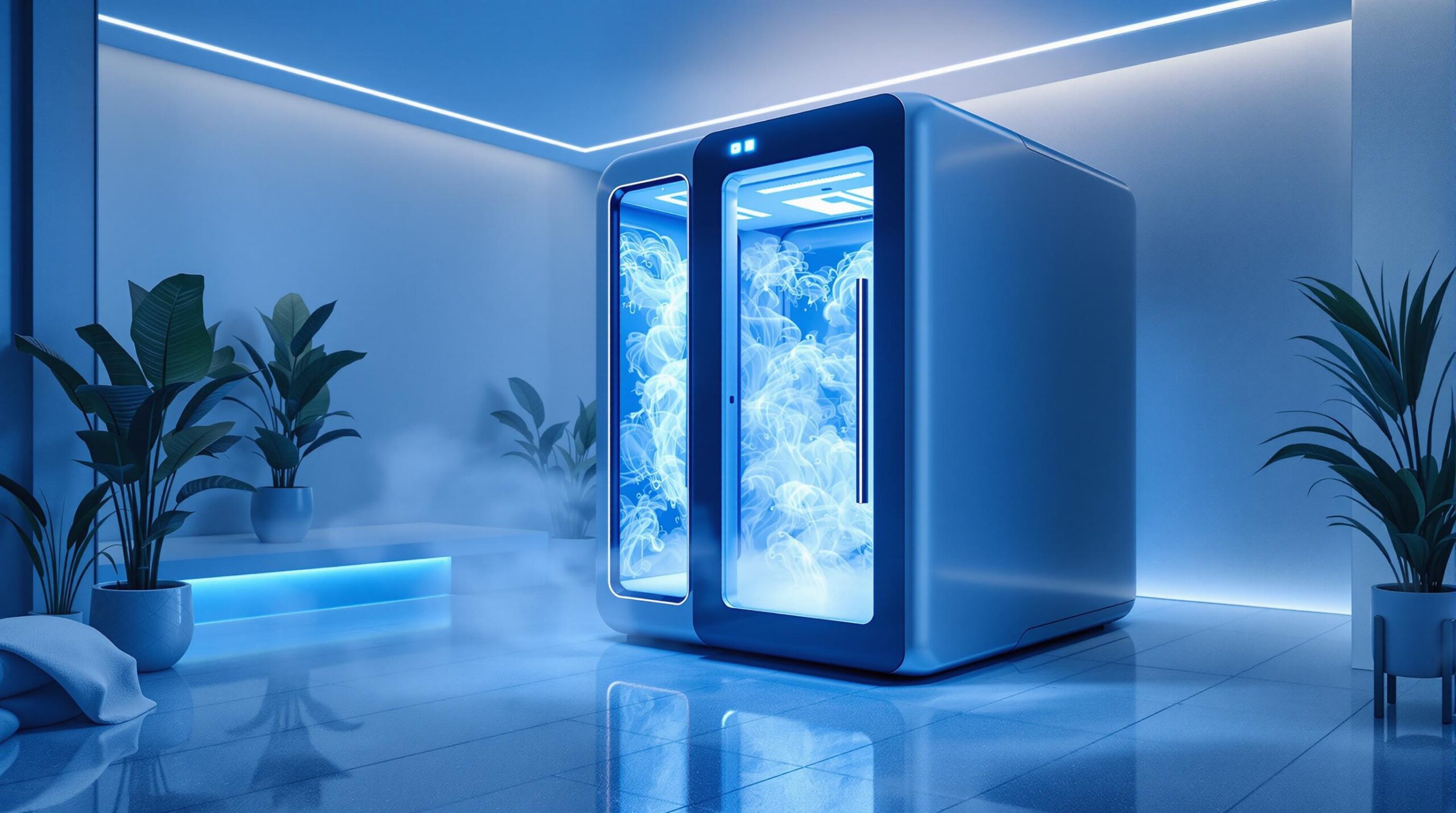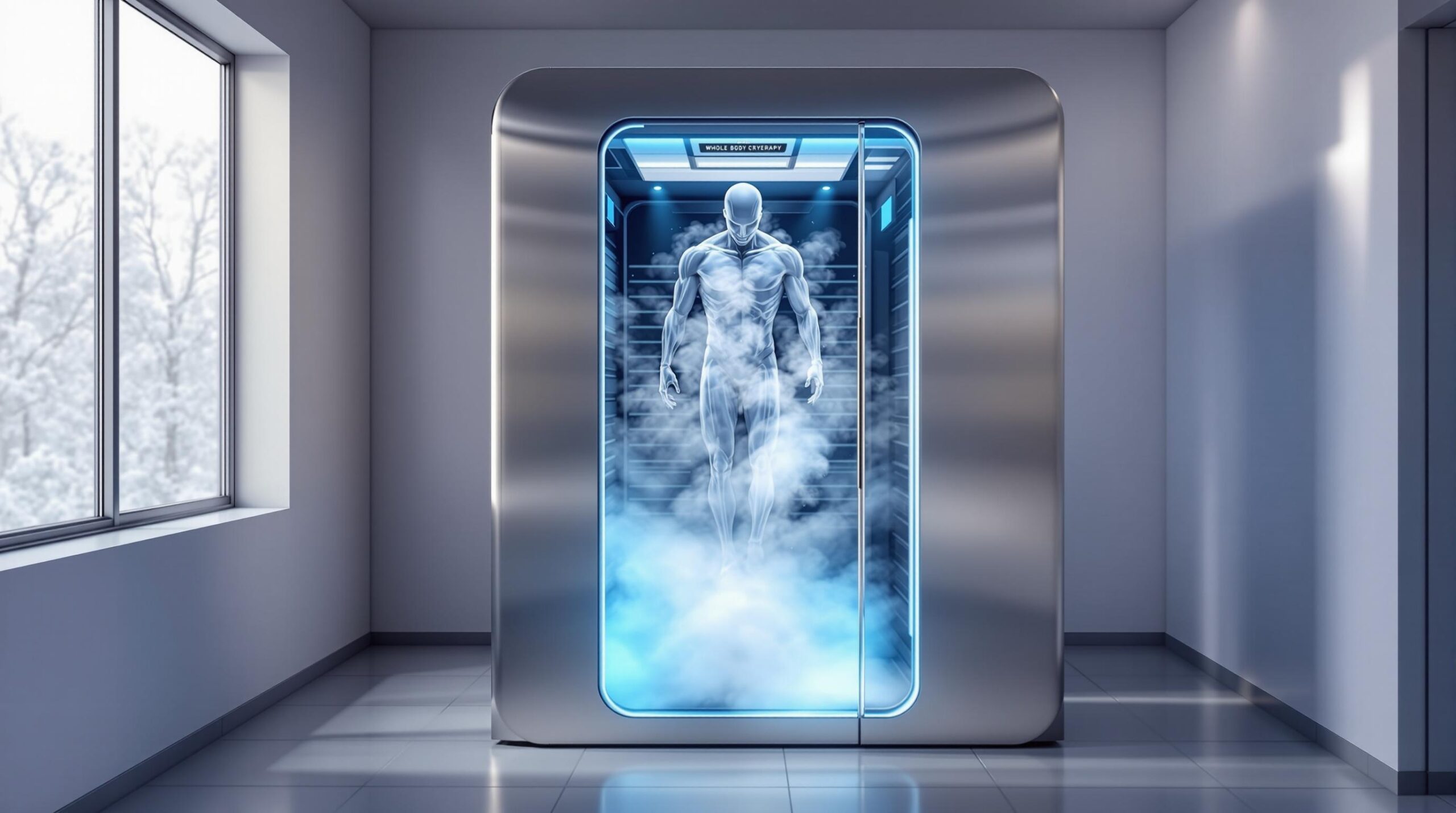Whole Body Cryotherapy (WBC) offers pain relief, faster recovery, and mental health benefits by exposing the body to extreme cold temperatures (–85°C to –140°C) for 3-5 minutes. Here’s what you need to know:
- Health Benefits: WBC can reduce inflammation, ease fibromyalgia symptoms, improve mood (up to 69% reduction in depressive symptoms), and support recovery from exercise and injuries.
- Athletic Recovery: Regular sessions lower muscle soreness, speed up recovery, and enhance performance. For example, athletes report up to 76% less inflammation after WBC.
- Mental Health: WBC boosts mood, decreases anxiety, and increases hormones like noradrenaline and testosterone.
- Safety: Electric cryochambers like those at The Cryo Hub are safer than nitrogen-cooled systems, with consistent temperatures and full-body immersion, including the head.
- Contraindications: Not suitable for people with uncontrolled heart conditions, circulation disorders, or during pregnancy.
Quick Comparison: Electric vs Gas-Cooled Cryochambers
| Feature | Electric Chambers (The Cryo Hub) | Gas-Cooled Chambers |
|---|---|---|
| Temperature Range | Consistent –85°C | As low as –160°C – with inconsistent cooling effects (cold air sinks) |
| Head Exposure | Full-head immersion | Head remains outside |
| Safety | No nitrogen risks | Potential nitrogen hazards |
| Environmental Impact | More eco-friendly | Relies on liquid nitrogen |
WBC delivers measurable results for recovery, mental health, and chronic pain. It’s a modern, non-invasive therapy gaining traction across wellness and sports sectors.
Case Studies: WBC Applications for Different Conditions
The Cryo Hub has shared several insightful case studies showcasing how Whole-Body Cryotherapy (WBC) is being used to address a variety of health challenges. These examples, backed by clinical research, highlight the potential of WBC to help manage chronic conditions and aid recovery.
Managing Fibromyalgia Symptoms
For individuals living with fibromyalgia, WBC has shown promise in easing symptoms. A controlled study revealed that participants experienced a notable reduction in pain levels. Pain scores on the Visual Analogue Scale dropped from 5.91 ± 2.3 mm at the outset to 3.43 ± 2.8 mm after six sessions (p < 0.0001) [4]. Furthermore, the Fibromyalgia Impact Questionnaire scores, which assess disease activity, improved significantly – from 60.7 ± 18.4 to 48.5 ± 23 (p = 0.0006) [4].
One compelling example is Liz, a client featured in The Cryo Hub’s February 2024 case study. After her first session at –85°C, Liz described the experience as feeling like a "pain-free massage", which made her daily life much easier:
"life is more ‘cope able’! The change in my mind and body was immeasurable" [5].
Liz’s story echoes the findings of broader clinical studies, where many fibromyalgia patients report high levels of satisfaction with WBC treatment [4].
Treating Anxiety and Mood Disorders
WBC has also shown potential in alleviating symptoms of anxiety and mood disorders. Research from Poland demonstrated that 15 sessions of WBC, each lasting 2–3 minutes, significantly reduced anxiety and depression scores (HDRS and HARS) [6].
The science behind this lies in the hormonal and neurochemical changes triggered by extreme cold exposure. WBC stimulates the release of adrenaline, noradrenaline, cortisone, and beta-endorphins, while also addressing chronic inflammation – a common factor linked to depression and anxiety [6]. A meta-analysis further highlighted its effectiveness, showing substantial improvements in depressive symptoms (Hedges’ g = 2.95, CI: 2.44–3.45), moderate gains in quality of life (Hedges’ g = 0.70, CI: 0.15–1.24), and a strong overall impact on mental health issues (Hedges’ g = 1.63, CI: 1.05–2.21) [7].
Beyond its role in mood disorders, WBC has potential benefits for neurological health.
Supporting Neurodegenerative Conditions
The Cryo Hub’s advanced electric cryochamber, maintained at –85°C, has been instrumental in supporting clients with neurodegenerative conditions. In July 2024, Chris, a Parkinson’s disease client, shared his experience of incorporating twice-weekly WBC sessions into his routine. He reported noticeable improvements in his mobility, gait, and arm coordination:
"My gait gets a lot better. I can walk in feeling very sluggish and after my sessions, I feel quite springy in my step and my gait is better when I leave" [8].
Research suggests WBC may also enhance cognitive function in individuals with mild cognitive impairment [10]. This is particularly relevant as the global senior population is expected to reach 2.1 billion by 2050, with 41% to 64% of those with mild cognitive impairment at risk of developing dementia [9][10].
The Cryo Hub’s electric cryochamber offers precise and consistent temperature control, which is especially beneficial for neurological conditions. Unlike gas-cooled systems, the electric cryochamber avoids temperature fluctuations, ensuring a stable cold exposure that effectively triggers anti-inflammatory responses.
Athletic Recovery and Performance Results
Athletes are increasingly turning to Whole-Body Cryotherapy (WBC) to enhance recovery and improve performance. The process involves a thermal shock that stimulates the production of anti-inflammatory cytokines and boosts circulation through alternating vasoconstriction and vasodilation [17].
Recent research [14] highlights how an athlete’s fitness level can influence these cytokine responses, with elite athletes showing different inflammatory patterns compared to recreational ones.
Accelerated Recovery from Muscle Soreness
WBC has proven effective in easing muscle soreness across various recovery stages. Studies reveal that it can reduce soreness at intervals of 1, 24, 48, and 72 hours after intense exercise [11]. This effect is linked to a combination of reduced muscle metabolism, decreased skin microcirculation, lower receptor sensitivity, and slower nerve conduction velocity [11].
For optimal recovery, evidence suggests undergoing five consecutive days of cryotherapy, with three or more sessions lasting around three minutes each, immediately after exercise and continuing over the next two days [13][15].
One study found that the inflammatory marker C-reactive protein (CRP) increased by 515% in a control group but rose by only 123% in a WBC group [15]. Similarly, a five-day training programme combined with WBC led to a 60% reduction in TNF-α levels, a key inflammatory cytokine [15].
| Recovery Metric | WBC Group | Control Group | Improvement |
|---|---|---|---|
| CRP Increase | 123% above baseline | 515% increase | Approx. 76% reduction |
| TNF-α Levels | 60% decrease | No change | Significant anti-inflammatory effect |
The benefits of WBC extend beyond muscle soreness. For instance, a study involving tennis players showed that those who underwent daily WBC sessions during a five-day training programme reached fatigue much later during challenging drills compared to a control group [15]. These physiological changes contribute to improved endurance and overall athletic performance.
Beyond the data, personal recovery stories highlight the practical benefits of WBC.
Case Study: Professional Athlete Recovery Results
Steve’s case study for injury recovery and athletic performance, offers a compelling example of WBC’s transformative effects. Following spinal surgery, Steve was left dependent on crutches, painkillers, and tranquillisers. However, during a family trip to Norway, he tried cold therapy for the first time. After just one session, he noticed a significant reduction in pain and better sleep. Within a week, he was walking unaided, and after two weeks, he no longer needed medication [17].
"From being on crutches and reliant on medication to walking freely again and pain free – in 2 weeks. That’s the power of the cold" [17].
Steve’s recovery continued upon his return to the UK, where he incorporated regular WBC sessions at The Cryo Hub. Over time, he progressed from limited mobility to running and practising martial arts, achieving fitness goals he once thought impossible. The Cryo Hub’s advanced electric cryochamber, maintained at –85°C, played a pivotal role in his recovery. Unlike gas-cooled systems, the electric chamber ensures consistent temperatures throughout each session, maximising therapeutic benefits. Today, Steve maintains his progress with 2–3 cryotherapy sessions per week, showcasing how WBC can support long-term recovery and performance [17].
Scientific findings back these experiences. In a study by Kruger et al., endurance-trained male athletes using WBC (3 minutes at –110°C) showed faster recovery during high-intensity intermittent exercise compared to a control group. The WBC group reported lower perceived exertion at submaximal intensities, improved oxygenation in the vastus lateralis muscle, and better heart rate and oxygen uptake values [16].
WBC also outperforms cold-water immersion in lowering skin temperature, although both methods show similar effects on muscle and core temperatures [14]. Meanwhile, Contrast Water Therapy is most effective for reducing the biochemical marker Creatine Kinase, but cryotherapy excels in alleviating Delayed Onset Muscle Soreness and improving jump recovery [12].
Cryotherapy Chamber Technology
Cryotherapy has come a long way, and the technology behind it has seen major advancements. Electric cryotherapy chambers, like The Cryo Hub’s model, are a shining example of how engineering can improve both safety and therapeutic results. These systems mark a significant step forward from traditional gas-cooled chambers, offering more consistent and user-friendly experiences.
The Benefits of Full-Head Immersion
One standout feature of The Cryo Hub’s electric cryochamber is its ability to provide true whole-body exposure, including the head. With temperatures set at –85°C, this full immersion delivers unique therapeutic benefits. Unlike chambers where the head remains outside, this setup allows for a more complete anti-inflammatory response.
Interestingly, exposing the head to cold air might stimulate the vagus nerve, which connects the brain to the abdomen, potentially unlocking additional benefits. While research on this is still ongoing, the idea is promising. The chamber’s spacious design also ensures users can move comfortably and breathe normally, despite the initial chill. Plus, full-head immersion targets facial nerves, enhancing the overall recovery process by promoting pain relief and aiding healing.
Temperature Consistency and Safety
In cryotherapy, maintaining a steady temperature is key. The Cryo Hub’s electric chamber keeps a consistent –85°C throughout each session, ensuring reliable results. Safety is also a top priority, with features like automatic timers, emergency alarms, and doors that open automatically if needed. Research shows that consistent cooling – not just extreme cold – yields the best therapeutic effects.
Safety statistics speak volumes. CryoBuilt, a well-known manufacturer of electric cryotherapy systems, has recorded over 10 million safe sessions, thanks to these built-in safety measures [18]. Another advantage is the use of breathable air instead of nitrogen, which eliminates risks like asphyxiation or nitrogen burns, issues sometimes associated with gas-cooled chambers.
Electric vs Gas-Cooled Chambers
Electric and gas-cooled cryotherapy chambers differ in several ways, with electric systems offering distinct advantages:
| Feature | Electric Chambers (The Cryo Hub) | Gas-Cooled Chambers |
|---|---|---|
| Temperature Range | –85°C | As low as –160°C |
| Temperature Control | Consistent throughout each session | Can vary during use |
| Safety | Uses breathable air; no nitrogen risks | Requires careful handling to avoid hazards |
| Head Exposure | Full-head immersion | Head typically remains outside |
| Operational Costs | Lower ongoing costs | Higher due to nitrogen use |
| Environmental Impact | More eco-friendly | Relies on liquid nitrogen supply |
Electric chambers like The Cryo Hub’s provide steady and safe cooling, making them a preferred choice for professionals. They’re also cost-efficient, with daily electricity expenses estimated at just £15 for 10 hours of operation [19]. While gas-cooled chambers can reach lower temperatures, they often focus on cooling the lower body, which limits their effectiveness. Electric systems also simplify operations with plug-and-play functionality, avoiding the complexities of handling liquid nitrogen.
The shift towards electric cryotherapy reflects a growing emphasis on safety, sustainability, and efficiency. By embracing this technology, the industry is not only improving user experiences but also reducing environmental impact while delivering the full benefits of whole-body cryotherapy.
Safety Guidelines and Contraindications
After exploring the intricacies of chamber technology, it’s important to focus on the safety measures that ensure effective cryotherapy sessions. While whole body cryotherapy (WBC) can deliver impressive therapeutic results, strict adherence to safety protocols is essential. The extreme cold involved requires careful preparation and professional supervision to guarantee both efficacy and safety.
Safe Cryotherapy Session Protocols
At The Cryo Hub, client safety is prioritised through a series of rigorous measures. Every session begins with a pre-treatment assessment to determine if the individual is a suitable candidate for WBC.
Clients are required to wear specific protective gear, including gloves, socks, slippers, and undergarments, all provided and properly fitted by The Cryo Hub. This ensures protection against frostbite while maintaining comfort during the session.
Trained staff oversee each session from start to finish, ready to intervene or terminate the session immediately if any adverse reactions occur. Sessions are kept brief, lasting between 2–4 minutes, and are managed using advanced safety features like automatic timers, emergency alarms, and self-opening doors. Additionally, the chamber uses breathable air instead of gas, eliminating the risk of oxygen displacement and ensuring a safe, stable environment.
Post-treatment care is just as crucial. Staff provide detailed guidance on keeping the skin hydrated and advise against sudden exposure to extreme temperatures immediately after the session to avoid any complications.
Next, let’s look at the conditions that make cryotherapy unsuitable for certain individuals to uphold the highest safety standards.
Who Should Avoid WBC?
Although WBC offers numerous benefits, its safety depends heavily on an individual’s health. Certain medical conditions can increase the risk of complications when exposed to extreme cold.
Cardiovascular conditions are among the most critical contraindications. People with uncontrolled high blood pressure (above 180/100 mmHg), recent heart attacks, unstable angina, irregular heart rhythms, or symptomatic cardiovascular disease should avoid WBC altogether.
"Individuals with Certain Cardiovascular Conditions Should Avoid Cryotherapy: Uncontrolled high blood pressure and heart disease can be exacerbated by the body’s response to extreme cold." – Pause Studio [20]
Circulation disorders also pose significant risks. Conditions like Raynaud’s syndrome, peripheral arterial disease, and venous thrombosis can impair the body’s ability to handle cold exposure safely.
"People with Poor Circulation or Cold-Related Sensitivities Are at Higher Risk: Conditions like Raynaud’s disease and cold urticaria can make cryotherapy unsafe due to the body’s reaction to cold temperatures." – Pause Studio [20]
Pregnancy is another key contraindication. The effects of extreme cold on pregnancy remain unstudied, and there is a potential risk of frostbite for individuals with nerve disorders. As a precaution, cryotherapy is not recommended for expectant mothers or those trying to conceive.
"Pregnancy and Nerve Disorders are Contraindications for Cryotherapy: The unknown effects on pregnancy and the potential for undetected frostbite in those with neuropathy make cryotherapy inadvisable." – Pause Studio [20]
Other contraindications include severe anaemia, bleeding disorders, active infections, tumour disease, lung disorders, uncontrolled seizures, acute kidney disease, cold allergies, and any conditions that affect sensation or involve a cardiac pacemaker.
If you have concerns about heart, nerve, or respiratory conditions, or if you’ve experienced adverse reactions to cold environments in the past, consulting your GP before booking a session is highly recommended. For those with higher risks, alternative therapies like contrast therapy, localised cryotherapy, cold compresses, mild cold water therapy, or infrared saunas may provide similar benefits without the intense physiological demands of WBC.
Being aware of these contraindications ensures that cryotherapy sessions can be tailored for safe and effective outcomes as you explore the broader applications of this technology.
sbb-itb-32603e3
Conclusion: Whole Body Cryotherapy Results
Case studies highlight the wide-ranging benefits of whole body cryotherapy (WBC) in areas like pain relief, mental health, injury recovery, and neurological conditions. Here’s a closer look at some of the key findings.
Key Takeaways
Research indicates that WBC can reduce symptoms of depression and anxiety by up to 69% compared to control groups [2]. For chronic pain sufferers, case studies from The Cryo Hub show how fibromyalgia patients have managed their symptoms without relying on medication [21]. Additionally, studies confirm WBC’s effectiveness in improving pain management for arthritis patients [3].
The Cryo Hub’s electric cryochamber, operating at –85°C, offers full head-to-toe immersion, ensuring even cooling across the body. This consistent exposure is essential for activating the central nervous system and delivering widespread benefits.
"Consistent skin temperature reduction is key to effective cryotherapy, which is best achieved through full-body exposure. Electric chambers outperformed nitrogen saunas in delivering these benefits." – Dr. Hausswirth [22]
Electric cryochambers have an impeccable safety record, with over 10 million treatments reported without incidents [22]. Research also shows that full-body cryotherapy enhances recovery outcomes by up to 25% compared to partial-body cooling methods [1]. At The Cryo Hub, client safety is prioritised through detailed health assessments, protective gear, and constant supervision by trained professionals.
Beyond managing pain and mental health, WBC has shown promise in other areas. Case studies report improvements in sleep quality, mood (including relief from post-partum low mood and exam-related stress), and even as an alternative to ice baths for cold therapy [21]. Encouraging results have also been observed in managing neurodegenerative conditions such as Parkinson’s Disease and Multiple Sclerosis [21].
These findings open the door to exploring WBC’s potential in even more applications.
Future Research Directions for WBC
With these positive outcomes, future research aims to further explore and refine the long-term benefits of WBC. Studies will focus on the sustained effects of regular treatments and investigate new ways WBC can help manage chronic conditions and aid recovery.
As the evidence base grows, WBC is increasingly positioned as a key element in modern wellness and therapeutic practices. Its combination of effective results, cutting-edge electric cryochamber technology, and stringent safety measures makes it an appealing option for those seeking non-pharmaceutical solutions.
FAQs
How can Whole Body Cryotherapy (WBC) help individuals with fibromyalgia, and what improvements can they expect?
Whole Body Cryotherapy (WBC) and Fibromyalgia Relief
Whole Body Cryotherapy (WBC) has shown promise in helping individuals with fibromyalgia by easing pain and enhancing overall well-being. Studies indicate that WBC can reduce pain levels by as much as 60%, with the effects often lasting for several months after treatment.
Beyond pain relief, WBC can also address other fibromyalgia symptoms like fatigue, anxiety, and sleep disturbances. These improvements can make a meaningful difference in daily life for those living with the condition. At The Cryo Hub, their advanced cryochamber provides full-body immersion, including the head, in a consistently cooled, electrically powered environment, ensuring effective support for managing fibromyalgia.
Why is The Cryo Hub’s electric cryochamber considered safer and more effective than traditional gas-cooled chambers?
The Cryo Hub’s electric cryochamber delivers a safer and more efficient cryotherapy experience by replacing nitrogen with breathable air. This approach eliminates risks like nitrogen burns, creating a safer and more user-friendly environment.
Unlike traditional chambers that rely on gas cooling, this advanced electric system ensures consistent, even temperatures throughout the session. That means no uncomfortable hot or cold spots, allowing for full-body immersion – including the head – for a more comfortable and effective therapy session. On top of that, the electric cooling system is a more environmentally conscious and dependable option, embodying a modern approach to whole-body cryotherapy.
What are the long-term benefits of regular Whole Body Cryotherapy for mental health and athletic recovery?
The Benefits of Regular Whole Body Cryotherapy (WBC)
Whole Body Cryotherapy (WBC) isn’t just a fleeting trend – it offers lasting advantages for both mental well-being and physical recovery, especially when done regularly.
Mental Health Support
For mental health, WBC has shown promise in easing symptoms associated with conditions like depression and anxiety. By lowering cortisol levels – the hormone often linked to stress – it helps promote a sense of calm and balance. Many who incorporate WBC into their routine report feeling more centred and at ease after consistent sessions.
Athletic Recovery
Athletes, on the other hand, appreciate WBC for its role in enhancing recovery. The exposure to extreme cold works wonders by reducing inflammation, easing muscle soreness, and accelerating the repair of exercise-induced muscle damage. Whether you’re a professional athlete or a fitness enthusiast, WBC has become a go-to method for bouncing back after intense training or competition.
At The Cryo Hub, their cutting-edge whole-body cryochamber delivers an even and consistent temperature throughout the session. It even includes full head immersion, ensuring you get the most out of every session.

